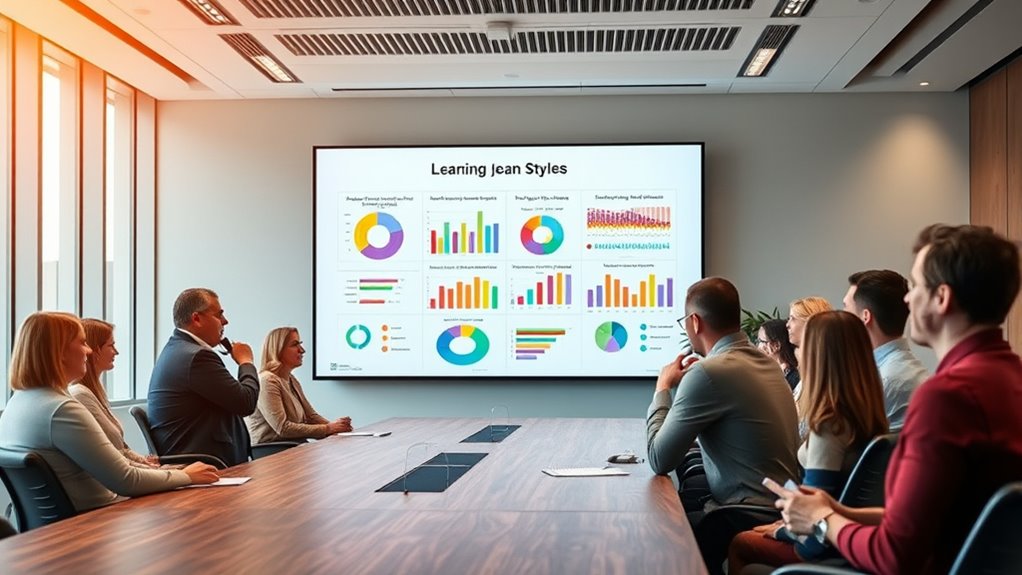Research shows that matching teaching methods to individual learning styles doesn’t improve student outcomes. Despite its popularity, there’s little scientific evidence to support this idea. Students don’t necessarily learn better when lessons align with their supposed preferences. Instead, effective teaching relies on varied, evidence-based strategies that focus on content and engagement. If you want to understand more about what truly enhances learning, keep exploring how teaching practices can be improved beyond fixed labels.
Key Takeaways
- Scientific reviews show little evidence that matching teaching styles to student preferences improves learning outcomes.
- Students do not necessarily learn better when instruction aligns with their self-identified learning style.
- Effective teaching relies more on content quality and diverse strategies than on fixed learning style models.
- Instructional flexibility and active engagement outperform rigid adherence to learning styles.
- Evidence-based practices emphasizing varied, multisensory approaches lead to better retention and understanding.

Have you ever wondered whether tailoring teaching methods to individual learning styles truly enhances student performance? It’s a common question in education, especially as many teachers and students believe that customizing instruction can make learning more effective. One approach that’s gained popularity is multisensory learning, which involves engaging multiple senses—visual, auditory, kinesthetic—to help students process information more deeply. Advocates argue that this method aligns with different learning preferences and boosts retention. But does the evidence support this? Not quite. While multisensory learning can make lessons more engaging, research shows that simply matching teaching methods to supposed learning styles doesn’t necessarily improve outcomes. Instead, what matters more is instructional customization—adapting teaching strategies based on the content and students’ needs rather than fixed learning styles.
Many studies have looked into whether learning styles actually determine how well someone learns. The idea is appealing: if students have a preferred way to learn, then teaching to that style should yield better results. However, exhaustive reviews of the evidence reveal that the concept of learning styles lacks strong scientific backing. In fact, the majority of rigorous research indicates that students don’t necessarily learn better when instruction matches their supposed style. For example, a student labeled as a visual learner doesn’t perform markedly better when taught through images rather than words or hands-on activities. This suggests that focusing on multisensory learning, while potentially beneficial for engagement, isn’t a magic bullet for improving academic achievement. Additionally, some studies emphasize that the effectiveness of instructional methods depends more on the quality of the content and delivery rather than the learner’s supposed style and the importance of evidence-based practices.
Instead, educational research points toward the importance of instructional flexibility—using a variety of teaching methods that address different types of content and learning goals. This approach, often called instructional customization, involves adjusting strategies to fit the material and the students’ evolving needs rather than rigidly adhering to a fixed learning style. For instance, when teaching complex concepts, combining visual aids, discussions, and practical exercises can make the learning process more effective. It’s about providing diverse, rich learning experiences that cater to multiple senses but not necessarily in the context of a fixed style. Moreover, research on learning strategies shows that emphasizing active engagement and varied instructional techniques enhances retention and understanding more than fixed learning styles. Implementing best practices in teaching ensures that educational strategies are grounded in evidence, promoting better learning outcomes overall. Recognizing the importance of evidence-based practices can help educators develop more effective and adaptable teaching methods that improve student success.
Frequently Asked Questions
Do Learning Styles Significantly Impact Student Achievement?
You might believe learning styles impact achievement, but neuroscience insights suggest otherwise. Research shows that emphasizing cognitive flexibility—your ability to adapt and learn in various ways—promotes better outcomes. Instead of tailoring instruction strictly to learning styles, focus on diverse methods that develop flexible thinking. This approach engages your brain more effectively, leading to improved achievement. So, fostering cognitive flexibility matters more than rigidly adhering to specific learning styles.
How Can Teachers Best Support Diverse Learning Preferences?
Imagine your classroom as a vibrant garden, each student a unique bloom needing tailored care. You can best support diverse learning preferences through personalized instruction that adapts to individual needs. Incorporate sensory engagement—visuals, sounds, hands-on activities—to breathe life into lessons. By nurturing each student’s strengths and preferences, you create a fertile environment where all can thrive and blossom into their fullest potential.
Are There Alternative Methods Proven More Effective Than Learning Styles?
You should focus on methods like multisensory instruction and fostering cognitive flexibility, which have proven more effective than relying solely on learning styles. By engaging multiple senses and encouraging adaptable thinking, you help students develop skills applicable across various subjects. These approaches promote deeper understanding and retention, ensuring your teaching methods are inclusive and evidence-based. Prioritizing these strategies improves learning outcomes more reliably than traditional learning style categorizations.
What Are the Psychological Theories Behind Learning Styles?
You might think learning styles are just preferences, but behind them lie powerful psychological theories. Cognitive preferences shape how you process information, influencing your learning strategies. Motivation theories explain why you stay engaged or lose interest, impacting your success. These theories suggest that understanding your cognitive preferences and motivation can dramatically transform your learning experience, making it more effective and personalized—almost like having a secret weapon for mastering new skills.
How Should Educational Policies Adapt to Current Evidence?
You should adapt educational policies by emphasizing multisensory techniques that engage multiple senses, enhancing learning for all students. Promoting cognitive flexibility allows students to switch between different approaches, improving adaptability and problem-solving skills. By focusing on these strategies, policies become more inclusive and effective, moving away from rigid learning styles and supporting diverse learner needs. This approach fosters a more dynamic, evidence-based educational environment.
Conclusion
Ultimately, the learning styles debate is like chasing a mirage—you think you’re getting closer to a secret formula, but the evidence shows there’s no one-size-fits-all approach. Instead of trying to fit everyone into neat boxes, focus on what works best for each person through varied, evidence-based methods. Remember, learning is a journey across a diverse landscape, not a single path; be open to exploring different routes to discover what truly helps you grow.










